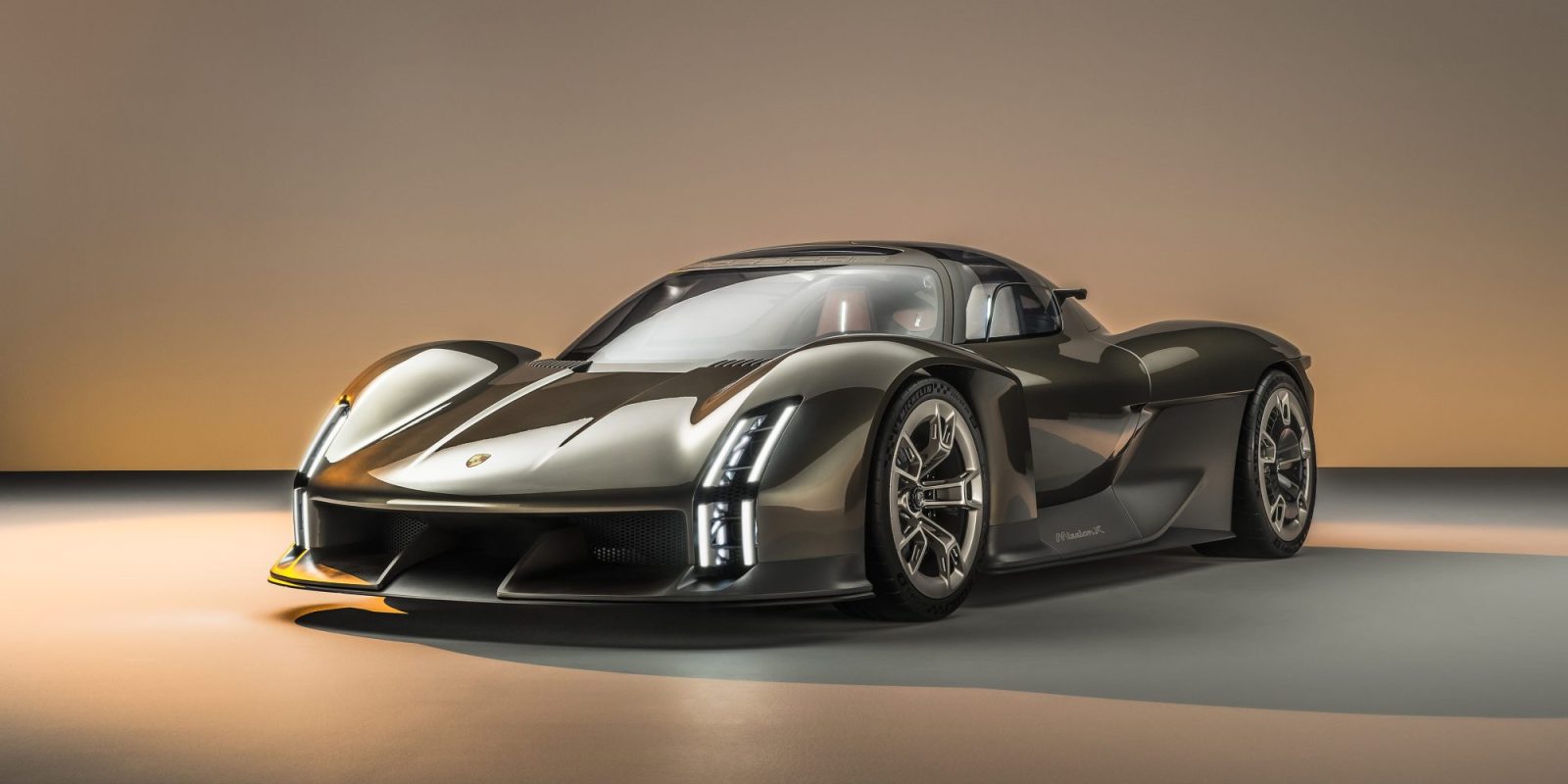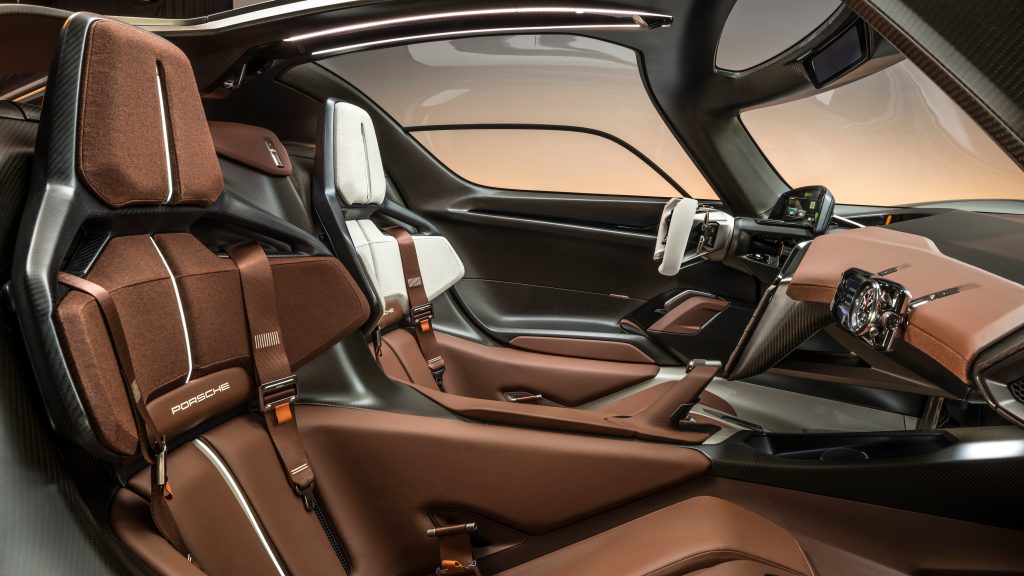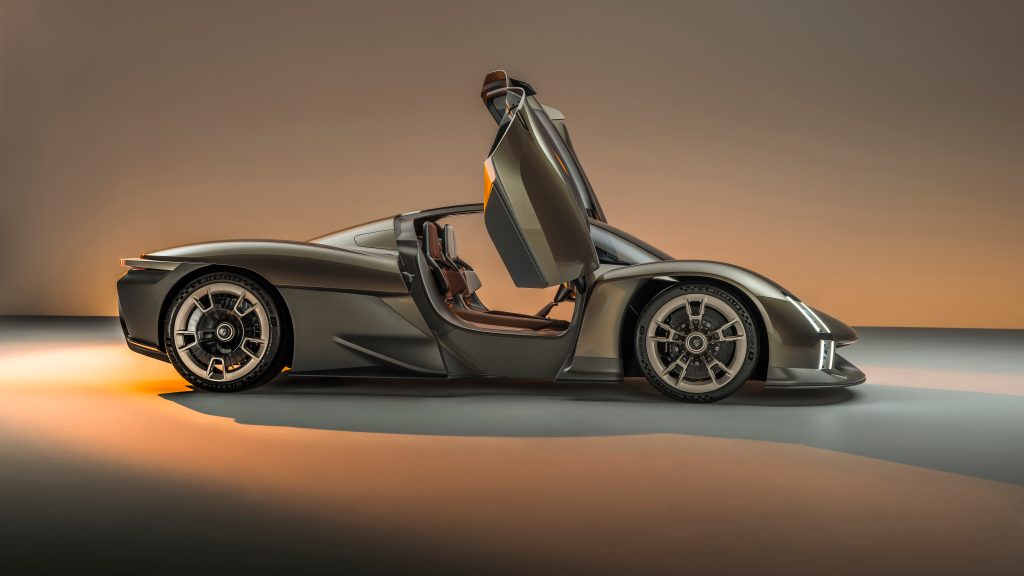
Porsche has unveiled the Mission X, a new electric hypercar concept, which the automaker says could be the fastest road-legal vehicle ever to do a lap around the famous Nürburgring racetrack… if it goes into series production.
The hypercar was shown as part of Porsche’s celebration of its 75th anniversary of making sports cars since the original Porsche 356 came out on June 8, 1948.
Porsche says the Mission X has an “ultra high-performance, efficient electric powertrain,” but though it doesn’t give tech specs, it gives us an idea of what they might be. The design considerations for this car include these points, which we’ll break down one by one:
- Be the fastest road-legal vehicle around the Nürburgring Nordschleife
- Have a power-to-weight ratio of roughly one hp per 2.2 lbs
- Achieve downforce values that are well in excess of those delivered by the current 911 GT3 RS
- Offer significantly improved charging performance with its 900-volt system architecture and charge roughly twice as quickly as the current Porsche frontrunner, the Taycan Turbo S
The first point is Porsche’s most common benchmarking method for its vehicles. Nürburgring Nordschleife, also known as “The Green Hell,” is a famously long and difficult track that runs through the Eifel forest in Germany. Recently, Porsche has been in a battle with Tesla over whose electric car is fastest around the track, and Tesla just struck back at Porsche to take back the record this past week.
Porsche would like to get that record back, but it sounds like it’s not just throwing down the gauntlet at Tesla but at all other cars. Tesla’s new production EV record 7:25 time is respectable (slotting near the Lamborghini Aventador, Ferrari Enzo, Mercedes AMG Black, and KTM X-Bow R) and is ten seconds ahead of Porsche’s previous EV record (but well behind the NIO EP9’s “production” EV lap record). However, Tesla is still nearly a minute off the plug-in hybrid Mercedes AMG One’s record of 6:30.705 for a street-legal vehicle.
But the AMG One is 1,049 hp in a 1,695 kg (3,737 lb) package. That’s powerful but also heavy, and weight is a killer in racing, especially around the curves that make up about five minutes of that six-minute Nürburgring lap. So that’s where the Mission X’s power-to-weight ratio comes in, and if Porsche meets its intentions, it’ll be a doozy.
A power-to-weight ratio of 1 horsepower per 2.2 lbs – or 1 hp/kg – is almost unheard-of, especially in road-legal vehicles. Only a few low-production hypercars have managed to achieve this feat, though most rely on forced induction (turbocharging). The Lotus Evija is the only other electric car claiming a similar power-to-weight ratio (1,970 hp in a 1,680 kg package).

High downforce is also a key component of racing, allowing cars to stick to the road better around turns at high speeds. Porsche says the Mission X will have more downforce than the GT3 RS, which is the best in the business at 409 kg (900 lbs) of downforce at 200 km/h (124 mph).
The Mission X will use active aerodynamics, so you have downforce when you need it and not when you don’t. This helps boost speeds on long straights (like the very long straight at the end of each Nürburgring lap) but also helps improve aerodynamic efficiency, which means less energy wasted, less battery needed, and more weight saved for more performance.
And lastly, Porsche wants to improve on its fast-charging performance from the Taycan, the current fastest-charging car on the road, by upgrading to a 900-volt system (like that seen on its previous Mission R concept) and doubling the Taycan’s peak 350 kW charge rate.
While we haven’t seen road cars capable of more than 350 kW, there have been proposals for 600 kW and 700 kW charging in Formula E and Electric GT racing, respectively. So if Porsche is targeting the Mission X as a racing monster, these are the numbers it would need to aim for.

The Mission X’s entire body is made of a carbon fiber reinforced plastic (CFRP) “exoskeleton.” CFRP is an expensive but light material that helps to keep power-to-weight ratios high. Carbon fiber body panels have been used on other EVs, namely the Tesla Roadster and CFRP in the BMW i3 and i8, and the Mission X’s forebear, the Carrera GT, had carbon fiber body panels as well.
The interior is driver-focused, with an asymmetrical design and color touches indicating such. The “yoke” steering wheel is reminiscent of racing wheels, featuring an open top for visibility, mode switches, and shift paddles (though Porsche makes no other mention of transmission in its press release).

And the battery is placed in a part of the car that we don’t see often anymore – behind the driver, instead of underneath. Most EV makers put batteries at the bottom of the car to help reduce the center of gravity, which is important for performance. But Porsche chose to put it behind the driver in the Mission X.
This means a slightly higher center-of-gravity but allows for a vehicle that is otherwise shorter – a height of 47.2 inches, just an inch and change taller than Porsche’s previous 918 and Carrera GT (and three inches taller than the original Tesla Roadster, which also carried the battery behind the driver).
It also makes for more traditional vehicle handling. Racing-focused cars are traditionally built with a mid-engine layout, where the heaviest part of the vehicle is behind the driver and in front of the rear axle. This enhances traction but reduces rotational inertia, which helps cornering ability. Housing the battery in that position will give a more traditional handling feel compared to the flat and low batteries of most road EVs these days.

Porsche has not yet committed to production officially. However, one line in its press release suggests this vehicle is likely to make its way into production in some form. Usually, concept cars make no mention of series production, but Porsche explicitly says, “If the Mission X goes into series production, then it should…” before listing the car’s capabilities. This explicit callout to series production suggests that this is more of a possibility than in the case of most concepts.
Further, the name is similar to Porsche’s Mission E, which was the concept name for what eventually became the Taycan. That concept attracted plenty of excitement and eventually made it to production, and this feels like an intentional callback.
Top comment by macb00kemdanno
I bet that it’ll still hit production before the second gen Tesla Roadster 😂
If it were to make it to production, it would do so as the latest entry in a storied list of low-production Porsche hypercars. It started with the Porsche 959, which was designed as a Group B rally car and ended up selling about 300 units to the public. Then came the Carrera GT, a 1,500-unit line that is thought of as one of the ultimate drivers’ vehicles of all time.
And more recently, the Porsche 918 plug-in hybrid brought electrification to the world of hypercars, with only 918 units made (carrying a base price of $845k). This was the first road vehicle to break the seven-minute barrier at Nürburgring. But its power-to-weight ratio was about 0.5 hp/kg, so the Mission X offers twice the relative power as its immediate predecessor.
All of these cars commanded high prices, and given the specs of the Mission X, we can imagine it would fit more into this market than into any of Porsche’s more common mass-production vehicles.
What do you think of the Mission X concept? Will Porsche make it? Can it deliver on its promises? Do you have seven figures of cash burning a hole in your pocket and are ready to order one? Let us know in the comments below.

FTC: We use income earning auto affiliate links. More.






Comments